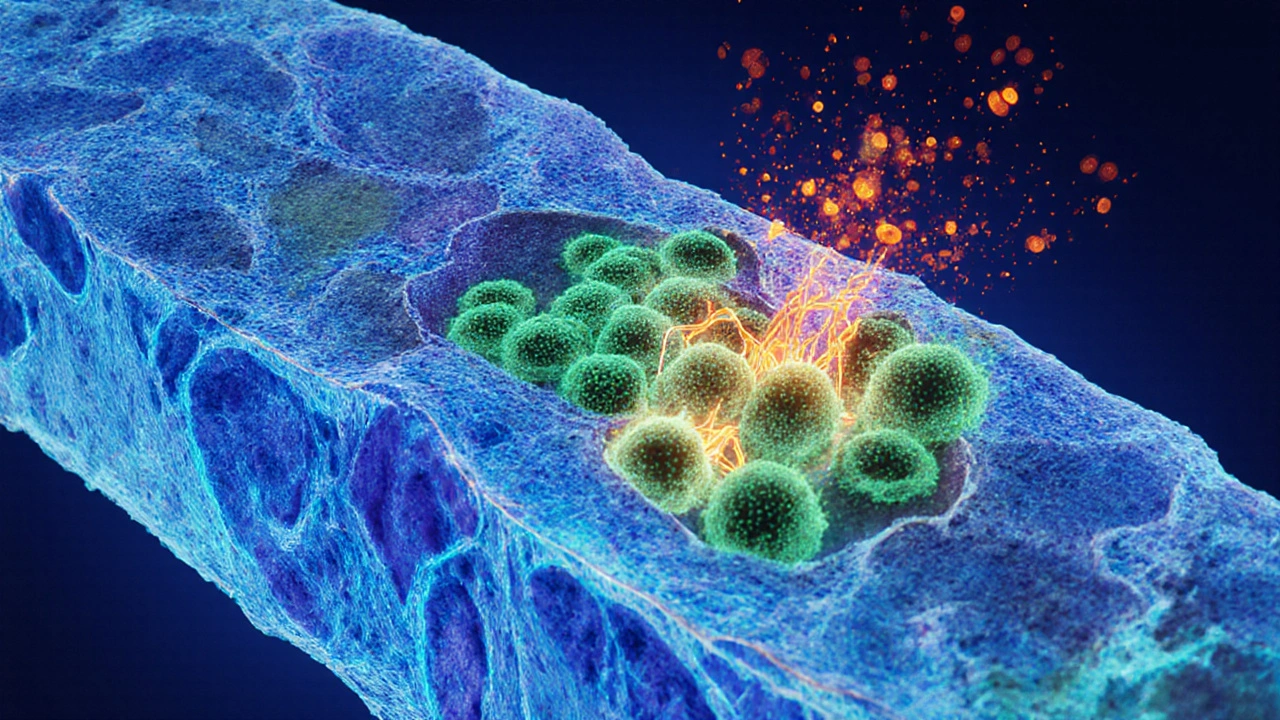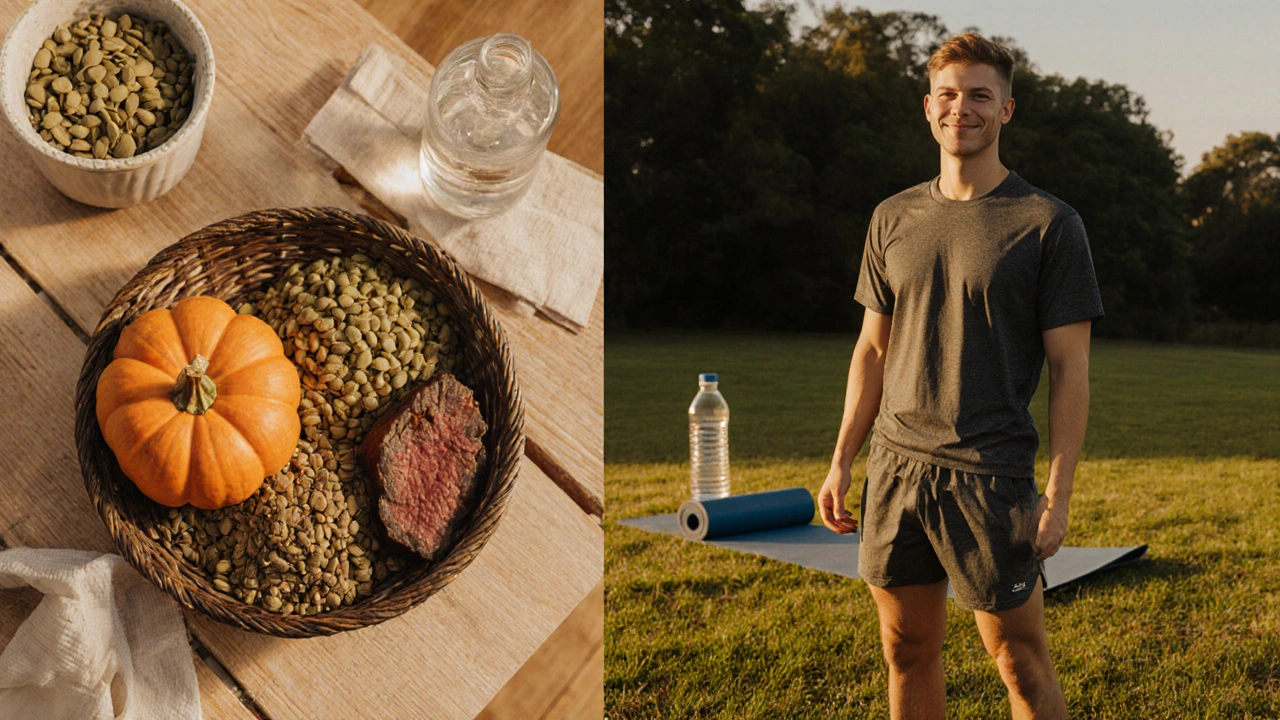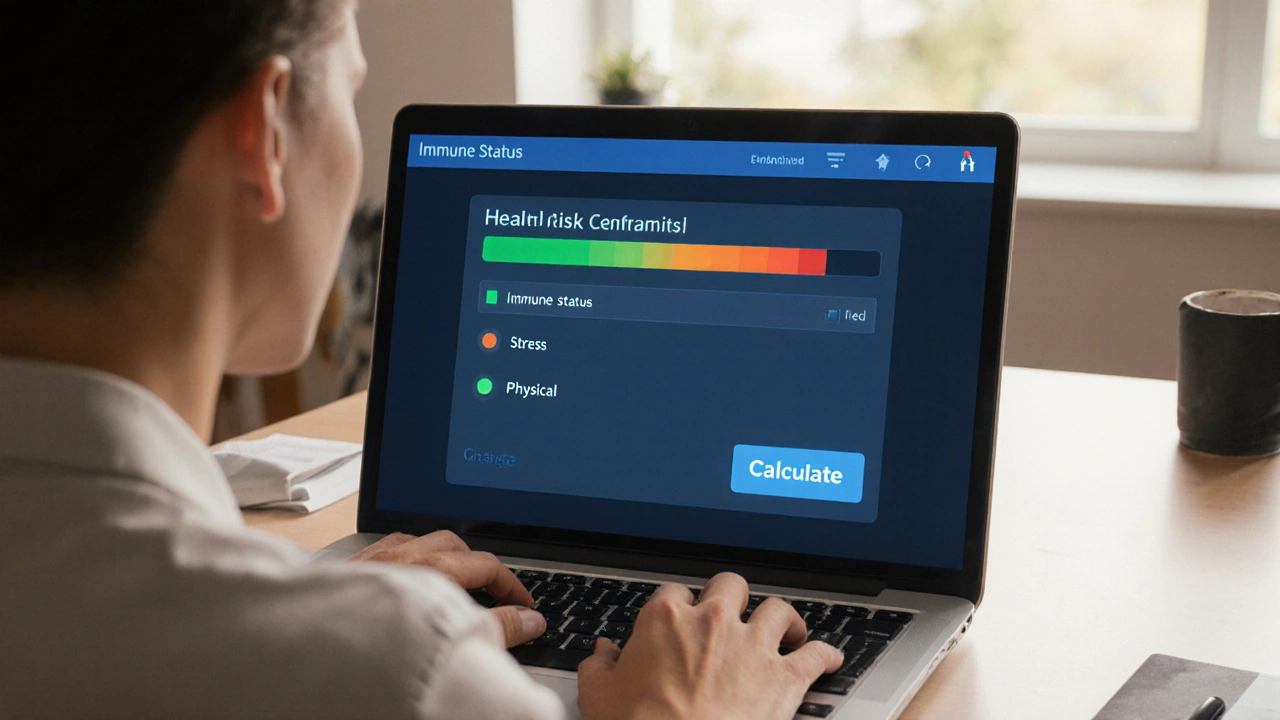Jock Itch Immune Health Risk Calculator
This tool evaluates how your immune health status affects your likelihood of developing jock itch and how quickly it might heal.
Your Risk Assessment
Robust Immunity
Low risk of jock itch. Quick healing with standard care.
Compromised Immunity
Moderate to high risk. Longer healing times needed.
Severely Compromised
High risk. Requires medical intervention and strict care.
Key Takeaways
- Jock itch (tinea cruris) is caused by dermatophyte fungi that thrive in warm, moist skin.
- A weakened immune system makes you more prone to fungal overgrowth and slows healing.
- Managing sweat, friction, and nutrition directly supports both skin health and immunity.
- Targeted lifestyle changes - adequate vitamin D, zinc, and probiotic intake - can lower recurrence rates.
- Early treatment combined with immune‑boosting habits cuts downtime and discomfort.
Ever wondered why a simple rash in the groin area seems to linger longer when you’re run down or sick? The answer lies in the jock itch immune system connection. This article breaks down the science, points out the hidden risk factors, and gives you a practical roadmap to keep both your skin and immunity in top shape.
What Is Jock Itch?
When most people hear "jock itch," they picture an itchy red patch on the inner thigh or groin. Medically, it’s known as Jock itch - also called tinea cruris - a fungal infection caused by dermatophyte species such as Trichophyton rubrum and Epidermophyton floccosum.
The fungus feeds on keratin, the protein that makes up the outer skin layer. Warm, humid environments, tight clothing, and excess sweating create the perfect breeding ground. Left unchecked, the infection spreads, causing redness, burning, and a classic “ring‑shaped” border.
Immune System Basics and Skin Defense
The Immune system a complex network of cells, tissues, and organs that protects the body from pathogens isn’t just about fighting viruses. It constantly patrols the skin, producing antimicrobial peptides and coordinating white‑blood‑cell responses that keep opportunistic fungi at bay.
When immune function dips - due to stress, poor nutrition, chronic disease, or medications - the skin’s frontline defense weakens. This is why people with diabetes, HIV, or even seasonal allergies often report more frequent or stubborn jock itch outbreaks.

The Biological Link: Dermatophytes Meet Immune Response
Dermatophytes belong to the broader class of Dermatophytes fungi that specialize in feeding on keratinized tissue like skin, nails, and hair. They release enzymes that break down keratin, allowing them to colonize the stratum corneum.
In a healthy host, innate immune cells (macrophages and neutrophils) recognize fungal cell wall components through pattern‑recognition receptors (PRRs). This triggers inflammation, recruiting more immune cells and releasing cytokines like IL‑1β and TNF‑α to curb growth.
When the immune system is compromised, the cytokine cascade blunts, allowing the fungus to proliferate unchecked. The result is a more extensive rash, deeper tissue involvement, and a longer healing timeline.
Risk Factors Tied Directly to Immune Health
- Chronic stress: Elevates cortisol, which suppresses T‑cell activity.
- Vitamin D deficiency: Reduces antimicrobial peptide production (cathelicidin).
- Zinc shortage: Impairs neutrophil chemotaxis and skin barrier integrity.
- Diabetes mellitus: High blood sugar fuels fungal growth and impairs microcirculation.
- Obesity: Increases skin folds, moisture, and systemic inflammation.
- Probiotic imbalance: A disrupted gut‑skin axis can lower systemic immunity.
Boosting Immunity to Prevent Jock Itch
- Optimize Vitamin D: Get 10‑15 minutes of midday sun 3‑4 times per week or supplement 1,000‑2,000 IU daily, especially during winter months.
- Incorporate Zinc‑rich foods: Beef, pumpkin seeds, lentils, and oysters provide 8‑15mg per serving.
- Stay hydrated and sweat‑smart: Use moisture‑wicking underwear, change after exercise, and dry the groin area thoroughly.
- Manage blood sugar: Aim for < 130mg/dL fasting; a balanced plate (half veg, quarter protein, quarter carbs) helps.
- Support the gut‑skin axis: Eat fermented foods (yogurt, kefir, kimchi) or a daily probiotic with Lactobacillus rhamnosus.
- Prioritize sleep: 7‑9 hours restores cytokine balance and T‑cell function.
- Reduce stress: Short daily breathing exercises or a 10‑minute walk lowers cortisol within weeks.

Practical Management Tips (Checklist)
- Clean the affected area with mild, pH‑balanced soap twice daily.
- Pat dry - never rub - using a clean towel.
- Apply an over‑the‑counter antifungal cream (clotrimazole 1% or terbinafine 1%) for 2‑4 weeks, even if symptoms improve.
- Switch to loose‑fitting, breathable cotton underwear; avoid synthetic blends that trap moisture.
- Use talc‑free powder only if it’s antifungal‑treated; regular baby powder can worsen fungal growth.
- Inspect the skin weekly for early signs, especially after workouts or hot weather.
- If lesions spread beyond the groin, involve the trunk, or persist after 4 weeks, consult a healthcare professional.
Immune Status vs. Jock Itch Symptoms (Comparison Table)
| Immune Status | Typical Symptoms | Healing Time | Recommended Care |
|---|---|---|---|
| Robust (no chronic disease) | Localized redness, mild itching | 7‑10 days with OTC antifungal | Standard hygiene + 2‑week cream |
| Compromised (diabetes, HIV, high stress) | Wider rash, burning, secondary bacterial infection | 2‑4 weeks or longer | Prescription antifungal, blood‑sugar control, immune support |
| Severely immunosuppressed (chemotherapy) | Deep tissue involvement, ulceration | Weeks to months | Systemic antifungal therapy, specialist referral |
Frequently Asked Questions
Can a strong immune system completely prevent jock itch?
A healthy immune system dramatically lowers the risk, but external factors like excessive moisture, tight clothing, and personal hygiene still play a role. Prevention works best when immunity and lifestyle are both optimized.
Is it safe to use natural remedies instead of antifungal creams?
Tea tree oil, apple cider vinegar, and coconut oil have modest antifungal properties, but clinical evidence is limited. For mild cases they can complement treatment, but severe or recurring infections should be addressed with proven OTC or prescription options.
How long should I keep using antifungal cream after symptoms disappear?
Continue for at least 2weeks beyond visible healing. This helps eradicate any lingering spores and reduces the chance of relapse.
Do vitamins actually help with fungal skin infections?
Vitamin D boosts antimicrobial peptide production, while zinc supports skin barrier repair and neutrophil function. Adequate levels can speed recovery, though they are not a stand‑alone cure.
When should I see a doctor for jock itch?
Seek medical attention if the rash spreads to the abdomen or thighs, shows signs of bacterial infection (pus, fever), persists after 4weeks of treatment, or if you have underlying conditions like diabetes that may complicate healing.


Thanks for the thorough guide! 😊
You've highlighted the immune link nicely; the way cortisol suppresses T‑cells is especially relevant, and it often gets overlooked. Additionally, maintaining proper skin hygiene can offset the fungal growth that thrives in moist environments, which is why daily cleaning matters. For those with diabetes, monitoring blood glucose levels is crucial, as hyperglycemia fuels fungal proliferation, and keeping sugars stable helps. Incorporating vitamin D and zinc into the diet can further reinforce antimicrobial peptide production, providing that extra defensive edge. Lastly, regular aerobic activity improves circulation, which aids in quicker recovery, so don't skip your workouts.
I totally agree with your points-keeping the skin dry is key. Even simple changes like swapping to moisture‑wicking briefs can make a big diff. Stay motivated and keep up the good habits! :)
Interesting how stress hormones actually hijack the immune response; it's a reminder to unwind regularly. A quick 10‑minute walk can lower cortisol enough to make a noticeable difference.
Great reminder! 🏃♀️ Regular movement not only boosts circulation, but also helps regulate hormones that keep fungi at bay. Pair that with a balanced diet rich in zinc and vitamin D, and you're basically building a fortress. Keep pushing forward, and your skin will thank you! 😄
When we think about jock itch, the first thing that comes to mind is often just a superficial fungal infection, but the underlying immunology tells a deeper story. The skin acts as a frontline barrier, populated by keratinocytes that constantly release antimicrobial peptides, a process heavily dependent on an intact innate immune response. If you're immunocompromised-whether from chronic disease, medication, or persistent stress-those peptides diminish, giving dermatophytes an opening to colonize. Moreover, cortisol, the primary stress hormone, directly suppresses T‑cell activation, reducing the adaptive immunity that would normally clear fungal spores. Vitamin D, on the other hand, upregulates cathelicidin, a peptide that has proven activity against a range of fungi, including Trichophyton species. Zinc deficiency compromises neutrophil chemotaxis, meaning your first responders to infection arrive late or in reduced numbers, prolonging the rash. High blood glucose levels, as seen in uncontrolled diabetes, create a nutrient‑rich environment for fungi and impair microvascular flow, slowing the delivery of immune cells to the affected area. Lifestyle factors intersect with these biological pathways: tight, non‑breathable clothing traps moisture, creating the humid microclimate fungi adore. Moisture‑wicking fabrics, on the contrary, facilitate rapid evaporation, keeping the groin dry and less hospitable. Regular aerobic exercise improves systemic circulation, delivering immune cells more efficiently throughout the body, while also modulating stress hormones. Sleep, often underestimated, is crucial; during deep REM cycles, cytokine production resets, preparing the immune system for the next day’s challenges. Probiotic intake can influence the gut‑skin axis, indirectly supporting systemic immunity and potentially reducing fungal overgrowth. In practice, a multi‑pronged approach works best: maintain rigorous hygiene, choose appropriate clothing, monitor blood sugar, supplement vitamin D and zinc if deficient, manage stress through meditation or yoga, and ensure adequate sleep. If symptoms persist beyond two weeks despite these measures, it’s wise to seek professional medical advice, as prescription‑strength antifungals may be required. Finally, remember that preventing recurrence is as important as treating the current episode; consistent habits will keep the fungus at bay and support overall immune resilience.
I've seen those risk calculators before, and they often hide how much data they collect. It makes you wonder if the advice is really unbiased.
The article is overly optimistic. Real life isn't that simple.
They keep pushing the idea that a simple supplement will fix everything, but you can't ignore the bigger picture. The pharma industry benefits from people buying over‑the‑counter creams instead of looking at root causes. Also, the mention of probiotics feels like a marketing ploy; not all strains work for skin issues. It's good to stay skeptical and read the fine print. Still, some of the lifestyle tips are solid, just don't take every claim at face value.
I see where you're coming from, but let's keep the conversation respectful. While some recommendations may sound commercial, many are backed by solid research. It's helpful to share credible sources so everyone can make informed choices.
Maintaining personal health responsibilities is essential; reliance on external aids should be balanced with disciplined self‑care.